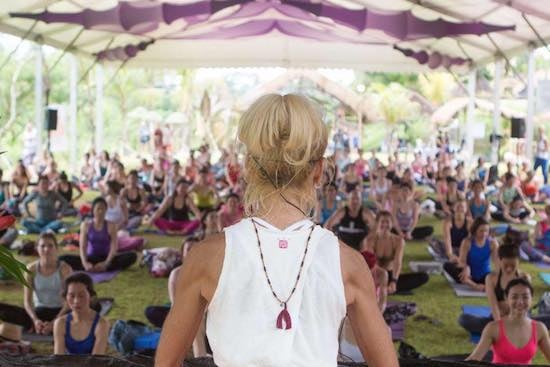
*Editor’s note: Elephant Journal articles represent the personal views of the authors, and can not possibly reflect Elephant Journal as a whole. Disagree with an Op-Ed or opinion? We’re happy to share your experience here.
~
Intro: My moody teen responds better to me after I’ve done this:
Our presence has power.
The Oxford Dictionary states: Presence is the state or fact of existing, occurring, or being present; A person or thing that exists or is present in a place but is not seen.
Our presence has energy and can be felt without even saying a word.
Therefore, it is vitally important that our minds are clear and in alignment with our intentions and focused on what we want to cultivate and manifest in our lives. What we think affects every single cell in our body, and we radiate our intentions out into the world like energetic messages.
We all have people in our lives who we simply love being around—even though we can’t put our finger on why. They are usually people who say very little and don’t talk mindlessly.
Two of my most influential teachers, Steve Ross and Dharma Mittra, are perfect examples of learning through the transmission of energy. They say few words, and yet energetically, and even psychically, the student receives knowledge, guidance, and healing.
I also feel this way around my husband. Simply by being in his presence, I feel a sense of comfort, love, and peace. Everything in my body softens; I feel a physical shift.
As a yoga teacher and student for over 25 years, this practice of presence is important and, I feel, the most powerful tool we have to heal the world. My major shift happened when I began traveling and teaching internationally five years ago.
My first experience of working with an interpreter was when I started traveling to China to teach yoga. I was nervous that not only would they not understand what I was saying, but that they also wouldn’t feel the power of my message. That somehow my teachings would literally get lost in translation.
During my first workshop in Shanghai, I was so inside my head, worrying about not being understood that I didn’t even feel like myself. Rather than the usual ease and flow of intuition and divine guidance, I felt a sort of disconnect and struggle in my teachings. When I arrived back to my hotel, I simply sat with it and meditated on my experience. After my meditation, I decided to let go of my small concerns about translating words, and just come into alignment with my purpose, trusting that the students would feel my intentions and that my presence would supersede my words.
I always say, “God knows my heart,” so why would this be any different?
The next day of workshops was a completely different experience. I was back in the flow, back in alignment, and tapped into pure joy and love. Because I was having much more fun teaching, my classes had more impact, and the students had more fun. Class attendance skyrocketed from that point on. The moment I got out of my head and into my heart, there was an ease and flow between myself, my interpreter, and the students.
Our true power lies in our ability to change our energy. We can put aside all our limited thoughts and belief systems and come into alignment with our authentic power. We need not rely on our words, but rather on our presence. If our presence doesn’t work, neither will our words.
Remember to get out of your way and let go of fear. When you feel yourself get caught up in your own craziness, allow the loving energy of the universe to guide you back into alignment. We can calibrate our energy and come back into alignment by meditating daily. Meditation strips away limitation, doubt, and fear. Our energy will tune in with the universe, and we become synchronized with the universal energy of love.
Here is a simple meditation practice that calms the sympathetic nervous system and shift us from “fight or flight” mode to comfort, where we trust that the universe is supporting us.
1. Sit comfortably, close your eyes, the backs of the hands should rest on your thighs or knees. Begin to tune into your breath, taking five to eight full inhalations and exhalations with a pause at the top (full of breath) and pause at the bottom of each complete exhalation.
2. Take five to eight sighing breaths. Deeply inhale and exhale an audible sigh that connects to the heart.
3. Take five to eight big yawns. The eyes may water—allow yourself to connect to that more empathetic energy flooding the body.
4. Next, briskly rub your hands together generating some heat and then place them over your eyes and face. Feel the healing powers of your own touch and allow that to soften the tension in the face.
5. Begin to massage the face with your hands, focusing on the jaw, jawline, base of the tongue, forehead, temples, and sinuses.
6. Release the backs of the hands onto the knees or thighs, with elbows softly bent in toward the waistline. The palms can be up or down. Gently press index fingers and thumbs together into Gyana or Chin Mudra. With your eyes closed, bring your awareness to your third eye point, in between the eyebrows, and fix your mind there. Yogis believe that when we bring our awareness to the third eye, we stimulate the pineal gland. The pineal gland is directly connected to insight, intuition, and spiritual discernment.
7. Sit in meditation for five minutes or as long as you’d like to. When the mind wanders, simply acknowledge it, and without judging or clinging, simply return your awareness back to the third eye point. If the mind wanders 100 times, then 100 times, return back to the third eye.
8. Close out your meditation with a simple prayer, chant (Om Shanti, Shanti, Shanti), or offering of thanks and gratitude.
~
Author: Tymi Howard
Images: Author’s Own
Editor: Catherine Monkman










Read 0 comments and reply